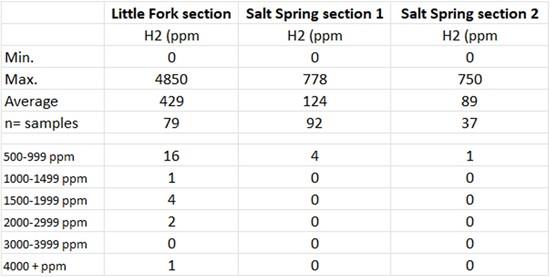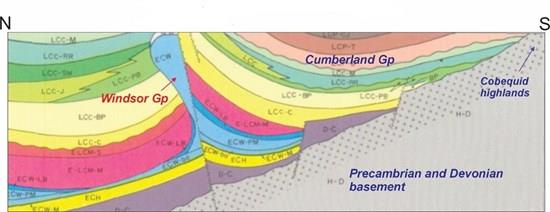QIMC Confirms Fourth Major Natural Hydrogen Zone In Nova Scotia With Soil-Gas Results Up To 4,850 Ppm - 2 Km Continuous Anomaly Along Windsor-Cumberland Fault
The analytical program returned over 24 readings above 500 ppm, four results between 1,500-1,999 ppm, two results between 2,000-2,999 ppm, and a high of 4,850 ppm - confirming the exceptional strength and extent of this anomaly.
This breakthrough further demonstrates the remarkable scale of hydrogen anomalies in Nova Scotia, adding to QIMC's three previously announced discoveries. With the identification of two principal hydrogen corridors on both sides of the Cumberland Basin, one in the East and one in the West of the province, separated by only a 1 hour 15 drive, this further demonstrates the regional scale necessary to support the development of a clean ammonia production hub.
"This fourth discovery validates our exploration thesis: Nova Scotia possesses the right geological conditions faulted and folded reservoirs, sealed by impermeable evaporites that can host large-scale natural hydrogen accumulations," said John Karagiannidis, President & CEO of QIMC. "With hydrogen zones confirmed on both sides of the Cumberland corridor, we are looking at the foundations of a regional development model, including ammonia production, built on multiple high-potential corridors."
The QIMC and INRS teams will be returning to Nova Scotia on October 5, 2025, to begin the next phases of development.
LITTLE FORKS-SPRINGHILL AREA CONTEXT
The exploration site, centered on the Little Forks-Springhill area, is located approximately 20 km NE of the Southampton area. The natural resources of the Springhill area are nationally recognized for its coal mines that have been in operation since the 19th century and for the use of the geothermal resource present in the vicinity of the old coal mines.
Overall, the Little-Forks-Springhill area shows topographic undulations reflecting a complex geology affected, among other things, by numerous NE-SW and E-W faults intersecting the carbonaceous rocks of the Cumberland Basin. The objective of the exploration program in the Little Fork-Springhill area was to evaluate the hydrogen potential of the western end of the Athol syncline (Fig. 1) and more specifically in a region affected by salt tectonics (saline diapirism) related to the emplacement of salt and anhydrite-gypsum domes of the Windsor Group (Fig. 2). This geological context, different from that of Southampton, is characterized by a verticalization of structures that could facilitate, among other things, the ascent of hydrogen from deep and hot sources due to a particularly high geothermal gradient in this part of Nova Scotia. The presence of evaporites within the Windsor Group is an important feature of the local geology and, in a potential hydrogen production context, these rocks could be used for hydrogen storage.
"The Ragged Reef sandstones provide excellent reservoir potential, the Windsor Group evaporites act as barriers, and the local geothermal gradient provides the driving energy for hydrogen migration," notes Prof. Marc Richer-Laflèche, INRS .

Figure 1. Simplified geological map showing the basement upwellings of the Cobequid and Hastings Highlands and the major synclines of the Cumberland region of Nova Scotia. Modified from Durling (2023).
To view an enhanced version of this graphic, please visit:
Geological Context
The geology of the Springhill area is complex because it is affected by salt tectonics related to the emplacement of diapirs of salt, anhydrite (and gypsum) formations rising through the carbonaceous sedimentary rocks of the Cumberland Group (Fig.2). This particular geology is accompanied by faults, deeper-dipping geological contacts, horst-like rock uplifts and folds. These structures can create traps and/or potential migration pathways for hydrogen.
Figure 2. Schematic geological section showing the influence of the placement of a Windsor Gp salt diapir in the rocks of the Cumberland Group. Note the verticalization of the structures in the vicinity of the diapir. Modified figure from Ryan et al. (1990).
To view an enhanced version of this graphic, please visit:
The geological map, highlighting the chaotic and discontinuous nature of the geology of the Springhill area, also shows the location of the sampling sites along the Little Fork and Salt Spring sections (sections 1 and 2) (Fig. 3). As for the Southampton exploration area, the highest concentrations of hydrogen in the soils are observed over the Carboniferous Ragged Reef Formation, which consists of alternating fluvial sandstones, conglomerates, mudstones, lake limestones and rare coal horizons. In the Cumberland Basin, the characteristics of the rocks in this geological formation appear to be highly favorable to the presence of hydrogen in the subsurface, especially when they are located near certain regional faults. On the other hand, the results of the measurements carried out over the salt, anhydrite and gypsum formations of the Windsor Gp (Fig. 3; Little Fork section) show very low soil-gas hydrogen concentrations of around 0 ppm, which confirms the very low permeability of the evaporite formations, which seem to constitute real barriers limiting the ascent of hydrogen. "In addition, it is important to note that evaporites are often associated with structural traps. Their density and rigidity can cause folding and faulting, creating potential traps for hydrogen," added Prof Richer-Laflèche.
Conceptually, it would be conceivable that reservoirs could form in the Ragged Reef Fm, as it contains coarse sandstone units (sublitharenite and subarkose sandstones) and conglomerates of high-energy river environments potentially favorable to the formation of quality reservoirs. These units are locally covered by shales and siltstones that can form relatively impermeable membranes.

Figure 3. Geological map of the Little Fork-Springhill area and location of geochemical surveys of hydrogen in soils. Modified map from Ryan et al. (1990).
To view an enhanced version of this graphic, please visit:
ANALYTICAL RESULTS FROM THE SOIL-GAS SURVEYS IN THE SPRINGHILL AREA
The work was carried out from 8 to 9 August 2025 under sunny weather conditions (average temperature of 30.7 °C, average atmospheric pressure of 1011.7 HPa and average relative humidity of 33.7 %). A total of 208 samples were collected from 3 sections totalizing 19.9 km along public roads of the Springhill area.
The mean and median hydrogen concentrations measured in the soils of this sector are particularly variable. Minimum, maximum and average concentrations are presented in table 1. The sections of the Soil-Gas surveys are presented in Figure 4 and the spatial distribution map of the hydrogen anomalies is presented in Figure 3.
Table 1: H2 soil-gas geochemistry in Little Forks-Springhill area public roads

To view an enhanced version of this graphic, please visit:

Figure 4. Sections showing the variability of soil hydrogen concentrations along the Little Fork and Salt Springs sections 1 and 2 of the Springhill area.
To view an enhanced version of this graphic, please visit:
About Pr. Marc Richer-LaFlèche, P.Geo.
Pr. Richer-Laflèche, a qualified expert in hydrogen exploration, has reviewed, read and approved the technical content presented in this press release. Pr. Richer-Laflèche confirms that the methodologies employed, data presented, and interpretations made conform to current industry practices and standards relating to hydrogen exploration .
About QIMC
Quebec Innovative Materials Corp. is a mineral exploration and development company dedicated to exploring and harnessing the potential of North America's abundant resources. With properties in Ontario, Quebec, Nova Scotia and Minnesota (US), QIMC is focused on specializing in the exploration of white (natural) hydrogen and high-grade silica deposits. QIMC is committed to sustainable practices and innovation. With a focus on environmental stewardship and cutting-edge extraction technology, we aim to unlock the full potential of these materials to drive forward clean energy solutions to power the AI and carbon-neutral economy and contribute to a more sustainable future.
QUÉBEC INNOVATIVE MATERIALS CORP.
John Karagiannidis
Chief Executive Officer
For further information, please contact:
Email: ...
Tel: +1 514-726-7058
REFERENCES
- Durling, P. 2023. Seismic-reflection interpretation of the carboniferous Cumberland Basin, northern Nova Scotia. Geological Survey of Canada Open File 2816-7155; 8937. 64 pages. Ryan, R.J, Boehner, R.C. and Deal, A., 1990. Maps ME 1990-012 and ME 1990-013: Cumberland Basin Geology Map. Cumberland County. Government of Nova Scotia, Department of Natural Resources and Renewables.
Neither the Canadian Securities Exchange nor its Regulation Services Provider (as that term is defined in the CSE policies) accepts responsibility for the adequacy or accuracy of this news release and has neither approved nor disapproved the contents of this news release.
Forward-Looking Statements
This news release contains statements that constitute "forward-looking statements". Such forward-looking statements involve known and unknown risks, uncertainties and other factors that may cause Québec Innovative Materials' actual results, performance or achievements, or developments in the industry to differ materially from the anticipated results, performance or achievements expressed or implied by such forward-looking statements. Forward-looking statements are statements that are not historical facts and are generally, but not always, identified by the words "expects," "plans," "anticipates," "believes," "intends," "estimates," "projects," "potential" and similar expressions, or that events or conditions "will," "would," "may," "could" or "should" occur.
Although Québec Innovative Materials believes the forward-looking information contained in this news release is reasonable based on information available on the date hereof, by their nature, forward-looking statements involve assumptions, known and unknown risks, uncertainties and other factors which may cause our actual results, performance or achievements, or other future events, to be materially different from any future results, performance or achievements expressed or implied by such forward-looking statements.
Examples of such assumptions, risks and uncertainties include, without limitation, assumptions, risks and uncertainties associated with general economic conditions in Canada and abroad; adverse industry events; future legislative and regulatory developments in the natural resources sector, in particular as regards the regulation of white (natural) hydrogen exploration, development and exploitation; the Company's ability to access sufficient capital from internal and external sources, and/or inability to access sufficient capital on favorable terms; natural resources industry and markets in Canada and generally; the ability of Québec Innovative Materials to implement its business strategies; competition; and other assumptions, risks and uncertainties.
The forward-looking information contained in this news release represents the expectations of the Company as of the date of this news release and, accordingly, is subject to change after such date. Readers should not place undue importance on forward-looking information and should not rely upon this information as of any other date. While the Company may elect to, it does not undertake to update this information at any particular time except as required in accordance with applicable laws.
Cautionary Statements This news release contains "forward-looking information" and "forward-looking statements" within the meaning of applicable Canadian securities legislation. These statements are based on expectations, estimates, and projections as of the date of this release. Forward-looking statements involve risks and uncertainties, which may cause actual results to differ materially from current expectations. Readers are cautioned not to place undue reliance on these statements, as no assurance can be provided regarding future outcomes.
To view the source version of this press release, please visit
SOURCE: Quebec Innovative Materials Corp.

Legal Disclaimer:
MENAFN provides the
information “as is” without warranty of any kind. We do not accept
any responsibility or liability for the accuracy, content, images,
videos, licenses, completeness, legality, or reliability of the information
contained in this article. If you have any complaints or copyright
issues related to this article, kindly contact the provider above.
Most popular stories
Market Research

- Alt.Town Introduces $TOWN Token Utility Across Platform Services And Launches Valuefi Deposit Event
- BTCC Exchange Maintains 143% Total Reserve Ratio In September 2025 Demonstrating Continued Financial Strength
- Salvium Solves The Privacy Paradox: Salvium One Delivers Mica-Compliant Privacy That Exchanges Can List
- Zebu Live 2025 Welcomes Coinbase, Solana, And Other Leaders Together For UK's Biggest Web3 Summit
- Tapbit At TOKEN2049: Reshaping The Crypto Landscape Through Product Innovation
- Thrivestate Launches“Fly Before You Buy” Program, Enabling International Buyers To Explore Dubai Before Committing























Comments
No comment